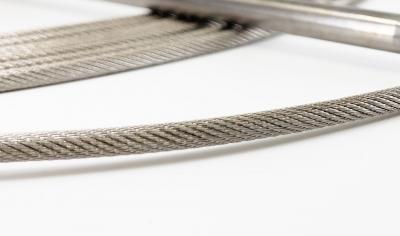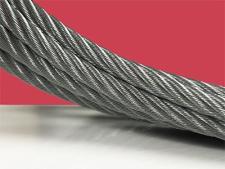What is anti-rotational cable?
In the simplest of terms, anti-rotational cable is a wire rope that resists the forces of rotation by layering opposing helical strands. This opposing approach to stranding the mechanical cable’s filaments ensures the wire rope does not unwind too far in either the clockwise or counterclockwise direction.
Anti-rotational cable does not necessarily possess zero rotation, however. Although it helps resist rotation better than a normally stranded cable, anti-rotation cable is a bit of a misnomer on its face.
Whenever one has a multi-stranded cable, the only way to keep it from unraveling is to ensure the outer diameter remains static, no matter the forces coming from the environment. The strands need to spin in a helical fashion to keep them all entwined together. That helps define an outer diameter for a multi-stranded cable.
So why would anti-rotational cable still possess negligible rotation?
Inherent in the geometry of anti-rotational cable are counter-stranded filaments, which like all mechanical cables, are left with empty space between the filaments themselves. These vacant areas between the wires allow the engineer to twist the cable in a counterclockwise direction, for instance, which tightens the spaces between the affected filaments. So, in this case, if the cable is turning counterclockwise, the wires stranded in that same direction tighten around one another, which provides spring force. This spring force opposes the rotation of the cable until it is at its tightest point, under which circumstances, the cable begins to rotate in the opposite direction.
Similar to a spring damper system, the anti-rotational cable is designed to quickly cease rotational inertia, permitting unwanted movement to stop swiftly and surgically.
Is Anti-rotational Cable Flexible?
Despite its less common strand design characteristics, anti-rotational cable is malleable, permitting the mechanical cable to bend around tight radii, such as in the case of pulleys.
As a matter, anti-rotational cable is not made more or less flexible based upon its design, as much as its material and the cable’s construction. For instance, 304 stainless steel cable, in a 19x19 construction, will possess more structural rigidity, behaviorally speaking, than tungsten of the same construction and diameter. This is because tungsten lays dead, like a shoelace in one’s hand, whereas the stainless steel alternative behaves more like piano wire. So anti-rotational cable is malleable, not because it’s anti-rotational, but because it's of a certain construction, material and diameter - all of which coalesce to determine degree of flexibility.
Anti-Rotation Compromises
Like most mechanical cable constructions and designs, anti-rotation cables come with some concessions. For example, anti-rotational cable is 10% weaker in tensile strength. If there is a 19x7 standard cable at a diameter of 3/16”, it will pull approximately 3,700 lbs. But, if the cable is a 19x7 anti-rotation cable of the same diameter, it will only pull around 3,300 pounds.
Another critical consideration when choosing anti-rotation cable is that they cannot be cut with mechanical cutters, or for that matter, with a hand tool. Anti-rotation cable must be electrocut, and the cut end simultaneously fused with molten material. This cut-and-weld progression ensures the anti-rotation cable filaments do not unwind, or fray, at the point the cut is executed.
What Sets Sava Apart?
Our engineers are experts in anti-rotational cable. Contact us to speak with one of our professionals and learn why Sava is an industry leader in cable manufacturing. You can also view our product catalog on our website.







